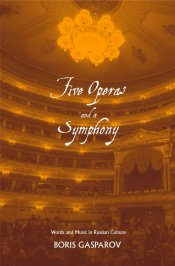Eight insightful essays that constitute the book show the social and political realities of pivotal moments in Russian history, from the 1830s to the 1930s, being reflected through the music of the time — a witness to and participant in these moments that is equal in significance to its contemporary literature. As the operatic stage had traditionally been the principal ideological battleground of Russia's musical scene over much of the time period discussed here, Gasparov focuses his attention almost exclusively on opera. A chapter each is devoted to Glinka's Ruslan and Liudmila, Tchaikovsky's Eugene Onegin and The Queen of Spades, and Musorgsky's Boris Godunov and Khovanshchina. The "symphony" in the book's title refers to Shostakovich's 4th, although even in this sole "instrumental" chapter, Lady Macbeth of Mtsensk District makes a cameo appearance.
One of the most fascinating aspects of the new book is Gasparov's easy command of Russian literature. This quality, unfortunately, may also detract from the pleasure of following his argument, unless the reader is at least somewhat familiar with the major creations of Pushkin, Gogol, Tolstoy, Dostoevsky, Chekhov, Bely, and Sholokhov. Most especially Pushkin: Four out of the five operas discussed in the book are based on that poet's oeuvre, in its various facets — a satirical "epic," a Shakespearean chronicle, a novel in verse, and a prose short story. Pushkin's creations present a powerful counterpoint to the main, "musical" theme of the book, as Gasparov sets out to explore and interpret a complex dialogue between a literary original and its re-conceptualization in an operatic libretto.
What makes this dialogue especially compelling (the author would call it "polyphonic," in a Bakhtinian sense) is its frequently temporal nature, in which the time-displaced visions of a plot and its characters collide, creating multidimensionality akin to a Cubist portrait. In Tchaikovsky's Onegin, for instance, Gasparov demonstrates how a shift in social mores from the Jane Austen-esque 1820s of the novel to the 1860-70s of Chernyshevsky's "new people" caused the composer's interpretation of the main characters' motivations to conflict fundamentally with Pushkin's original. The characters of The Queen of Spades, as the author persuasively argues, negotiate a dizzying temporal multiplicity: the 1770s of the libretto, the 1830s of Pushkin's "anecdote," Tchaikovsky's own 1870s, and the 1890s — the Symbolist present in which the opera first appeared, and upon which it had cast such a powerful spell. Particularly interesting is Gasparov's take on Ruslan and Liudmila — an opera so complex and misunderstood that it tends to be avoided by both stage directors and musicologists. Here, the author suggests, we witness a four-part dialogue between the original tongue-in-cheek "fairy tale" penned by an 18-year-old poet, his own revised version of the work, the 1830s of Glinka's Life for the Tsar triumph, and the early 1840s — the time when the opera finally came together. The conflict between these four versions of the plot, Gasparov suggests, is the cause of the alleged dramaturgical contradictions that have plagued Ruslan's stage history since its premiere. Taking them into account, meanwhile, may offer us a newly unified and plausible concept of Glinka's masterpiece.
Giving a detailed account of Gasparov's arguments throughout the book would be a disservice to my readers — as indefensible as revealing the ending of a thrilling "whodunit." So I shall only mention his view of Musorgsky's Khovanshchina as a musical counterpart of its contemporary psychological prose (specifically Dostoevsky's Demons) and of Shostakovich's 4th symphony as a (perhaps subversive) mirror of sorts to the newly created Socialist-Realist novel. The chapter on Boris Godunov, meanwhile, takes us to turn-of-the-century Paris and reveals a few remarkable traces of Musorgsky's chef-d'oeuvre not only — predictably — in Debussy's style, but also in the score of Puccini's Turandot.
A discussion of the "Russianness" in Russian music is a leitmotiv throughout Gasparov's book. He tracks along familiar territory (staked out some time ago by Richard Taruskin in Defining Russia Musically) of folk song, liturgical singing, the rising sixths of urban romance, and offers the pre-modernist progressions of loosely functional diatonicism as a Russian counterpart to teleological Wagnerism of late-Romantic, Western-European harmony. In this discussion lie perhaps the weakest points of the otherwise superb study, including a couple of annoyingly obvious mistakes in harmonic analysis in Chapter 1. On the other hand, the discussion of musical language also yields some of the most brilliant insights of the volume, including its beautifully amusing epilogue that comments on the troubled history of the Soviet State anthem — a most revealing example of a musical message outlasting a verbal one.
Overall, Gasparov's book is an exciting read. While some of the author's interpretations may prove controversial (on more than one occasion I was tempted to point out that sometimes a cadence is just a cadence…), they are always compelling. This enjoyable ride through music and history gets my highest recommendation: it is essential for all students of Russian culture, and — with a little effort perhaps — accessible to a wider audience as well.
Olga Haldey
University of Missouri—Columbia
